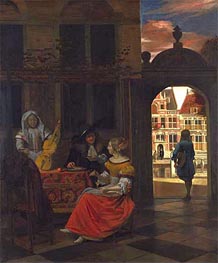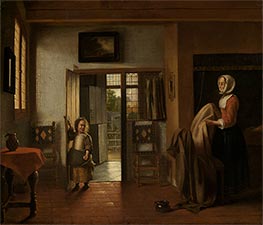Pieter de Hooch Painting Reproductions 1 of 1
1629-1684
Dutch Baroque Painter
Pieter de Hooch also spelled "Hoogh" or "Hooghe") (baptized December 20, 1629 - 1684) was a genre painter during the Dutch Golden Age. He was a contemporary of Dutch Master Jan Vermeer, with whom his work shared themes and style.
De Hooch was born in Rotterdam to Hendrick Hendricksz de Hooch, a bricklayer, and Annetge Pieters, a midwife. He was the eldest of five children and outlived all of his siblings. He studied art in Haarlem under the landscape painter, Nicolaes Berchem. Beginning in 1650, he worked as a painter and servant for a linen-merchant and art collector named Justus de la Grange. His service for the merchant required him to accompany him on his travels to The Hague, Leiden, and Delft, to which he eventually moved. It is likely that de Hooch handed over most of his works to la Grange during this period in exchange for board and other benefits, as this was a common commercial arrangement for painters at the time, and a later inventory recorded that la Grange possessed eleven of his paintings.
De Hooch was married in Delft in 1654 to Jannetje van der Burch, by whom he fathered seven children. While in Delft, de Hooch is also believed to have learned from the painters Carel Fabritius and Nicolaes Maes, who were both early members of the Delft School. He became a member of the painters' guild of Saint Luke in 1655, and had moved to Amsterdam by 1661.
The early work of de Hooch, like most young painters of his time, was mostly composed of scenes of soldiers in stables and taverns, though he used these to develop great skill in light, color, and perspective rather than to explore an interest in the subject matter. After beginning his family in the mid-1650s, he switched his focus to domestic scenes and family portraits. His work showed astute observation of the mundane details of everyday life while also functioning as well-ordered morality tales. These paintings often exhibited a sophisticated and delicate treatment of light similar to those of Vermeer, who lived in Delft at the same time as de Hooch. 19th century art historians had assumed that Vermeer had been influenced by de Hooch's work, but the opposite is now believed.
Though he began to paint for wealthier patrons in Amsterdam, he lived in the poorest areas of the city. Around this time, de Hooch's painting style became coarser and darker in color, and his simple domestic scenes were replaced by highly-decorated images set in palatial halls and country villas. Most scholars believe that de Hooch's work after around 1670 became more stylized and deteriorated in quality. It has been surmised that this was in part due to deteriorating health; de Hooch died in 1684 in an Amsterdam insane asylum, though how he came to be there is unrecorded.
De Hooch was born in Rotterdam to Hendrick Hendricksz de Hooch, a bricklayer, and Annetge Pieters, a midwife. He was the eldest of five children and outlived all of his siblings. He studied art in Haarlem under the landscape painter, Nicolaes Berchem. Beginning in 1650, he worked as a painter and servant for a linen-merchant and art collector named Justus de la Grange. His service for the merchant required him to accompany him on his travels to The Hague, Leiden, and Delft, to which he eventually moved. It is likely that de Hooch handed over most of his works to la Grange during this period in exchange for board and other benefits, as this was a common commercial arrangement for painters at the time, and a later inventory recorded that la Grange possessed eleven of his paintings.
De Hooch was married in Delft in 1654 to Jannetje van der Burch, by whom he fathered seven children. While in Delft, de Hooch is also believed to have learned from the painters Carel Fabritius and Nicolaes Maes, who were both early members of the Delft School. He became a member of the painters' guild of Saint Luke in 1655, and had moved to Amsterdam by 1661.
The early work of de Hooch, like most young painters of his time, was mostly composed of scenes of soldiers in stables and taverns, though he used these to develop great skill in light, color, and perspective rather than to explore an interest in the subject matter. After beginning his family in the mid-1650s, he switched his focus to domestic scenes and family portraits. His work showed astute observation of the mundane details of everyday life while also functioning as well-ordered morality tales. These paintings often exhibited a sophisticated and delicate treatment of light similar to those of Vermeer, who lived in Delft at the same time as de Hooch. 19th century art historians had assumed that Vermeer had been influenced by de Hooch's work, but the opposite is now believed.
Though he began to paint for wealthier patrons in Amsterdam, he lived in the poorest areas of the city. Around this time, de Hooch's painting style became coarser and darker in color, and his simple domestic scenes were replaced by highly-decorated images set in palatial halls and country villas. Most scholars believe that de Hooch's work after around 1670 became more stylized and deteriorated in quality. It has been surmised that this was in part due to deteriorating health; de Hooch died in 1684 in an Amsterdam insane asylum, though how he came to be there is unrecorded.
3 Pieter de Hooch Paintings

A Musical Party in a Courtyard 1677
Oil Painting
$3175
$3175
Canvas Print
$70.02
$70.02
SKU: HOP-7849
Pieter de Hooch
Original Size: unknown
National Gallery, London, UK
Pieter de Hooch
Original Size: unknown
National Gallery, London, UK

The Linen Chest 1663
Oil Painting
$3544
$3544
Canvas Print
$76.89
$76.89
SKU: HOP-8206
Pieter de Hooch
Original Size: 70 x 75.5 cm
Rijksmuseum, Amsterdam, Netherlands
Pieter de Hooch
Original Size: 70 x 75.5 cm
Rijksmuseum, Amsterdam, Netherlands

In the Bedroom c.1658/60
Oil Painting
$2386
$2386
Canvas Print
$71.85
$71.85
SKU: HOP-18924
Pieter de Hooch
Original Size: 51.8 x 60.6 cm
Staatliche Kunsthalle, Karlsruhe, Germany
Pieter de Hooch
Original Size: 51.8 x 60.6 cm
Staatliche Kunsthalle, Karlsruhe, Germany